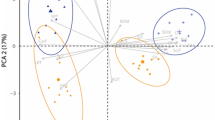Abstract
A survey of the responsiveness of plant species, typical of open and shade habitats, to simulated natural shade-light quality (i.e. white light plus supplementary far-red) has demonstrated a systematic relationship between habitat and certain developmental responses. Supplementary far-red light has a much greater effect on stem extension rate, petiole length, and leaf dry weight: stem dry weight ratio of the open habitat, shade-intolerant species. Far-red effects on leaf chlorophyll content show no such systematic grading. These results are discussed in relation to habitat adaptation. In most cases, the relationship between developmental response and the estimated phytochrome photoequilibrium, which is established by the radiation treatment, is linear. This is taken as an indication of phytochrome involvement in shade perception.
Similar content being viewed by others
Abbreviations
- P fr :
-
far-red light absorbing form of phytochrome
- P total :
-
total phytochrome
- PAR:
-
photosynthetically active radiation
References
Björkman, O., Holmgren, P.: Adaptability of the photosynthetic apparatus to light intensity in ecotypes from exposed and shaded habitats. Physiol. Plant. 16, 889–914 (1963)
Björkman, O., Holmgren, P.: Photosynthetic adaptation to light intensity in plants native to shaded and exposed habitats. Physiol. Plant. 19, 854–859 (1966)
Blackman, G.E., Wilson, G.L.: Physiological and ecological studies in the analysis of the plant environment. VII. An analysis of the differential effects of light intensity on NAR, LAR and RGR of different species. Ann. Bot. NS 15, 373–408 (1951)
Blackman, G.E., Wilson, G.L.: Physiological and ecological studies in the analysis of the plant environment. IX. Adaptive changes in the vegetative growth and development of Helianthus annuus induced by an alteration in light level. Ann. Bot. NS 18, 71–94 (1954)
Buttery, B.R., Buzzell, R.I.: The relationship between chlorophyll content and rate of photosynthesis in soybeans. Can. J. Plant Sci. 57, 1–5 (1977)
Clapham, A.R., Tutin, T.G., Warburg, E.F.: Flora of the British Isles. Cambridge University Press 1962
Fitter, A.H., Ashmore, C.J.: Response of two Veronica species to a simulated woodland light climate. New Phytol. 73, 997–1001 (1974)
Fredericq, H., De Greef, J.: Red, far-red photoreversible control of growth and chlorophyll content in light grown thalli of Marchantia polymorpha L. Naturwissenschaften 53, 337 (1966)
Gabrielsen, E.K.: Effects of different chlorophyll concentrations on photosynthesis in foliage leaves. Physiol. Plant. 1, 5–37 (1948)
Grime, J.P.: Shade avoidance and shade tolerance in flowering plants, In: Light as an ecological factor, British Ecological Soc. Symp. pp. 187–207, Bainbridge, R., Evans, G.C., Rackham, O., eds. Oxford: Blackwell 1966
Grime, J.P., Hunt, R.: Relative growth rate; its range and adaptive significance in a local flora. J. Ecol. 63, 393–422 (1975)
Holmes, M.G., Smith, H.: The function of phytochrome in the natural environment. I. Characterisation of daylight for studies in photomorphogenesis and photoperiodism. Photochem. Photobiol. 25, 533–538 (1977a)
Holmes, M.G., Smith, H.: The function of phytochrome in the natural environment. II. The influence of vegetation canopies on the spectral energy distribution of natural daylight. Photochem. Photobiol. 25, 539–545 (1977b)
Holmes, M.G., Smith, H.: The function of phytochrome in the natural environment. IV. Light quality and plant development. Photochem. Photobiol. 25, 551–557 (1977c)
Hughes, A.P., Evans, G.C.: Plant growth and the aerial environment: II. Effects of light intensity on Impatiens parviflora. New Phytol. 61, 154–174 (1962)
Hutchinson, T.C.: Ecotype differentiation in Teucrium scorodonia with respect to susceptibility to lime-induced chlorosis and to shade factors. New Phytol. 66, 439–453 (1967)
Jarvis, P.G.: The adaptability to light intensity of seedlings of Quercus patraea. J. Ecol. 52, 545–571 (1964)
Kasperbauer, M.J., Hiatt, A.J.: Photoreversible control of leaf shape and chlorophyll content in Nicotiana tabacum. Tob. Sci. 10, 29–32 (1966)
Loach, K.: Shade tolerance in tree seedlings. I. Leaf photosynthesis and respiration in plants raised under artificial shade. New Phytol. 66, 607–621 (1967)
Mackinney, G.: Absorption of light by chlorophyll solutions. J. Biol. Chem. 140, 315–322 (1941)
McCree, K.J.: Test of current definitions of photosynthetically active radiation against leaf photosynthesis data. Agric. Meteorol. 10, 443–453 (1972)
Morgan, D.C., Smith, H.: Linear relationship between phytochrome photoequilibrium and growth in plants under simulated natural radiation. Nature 262, 210–212 (1976)
Morgan, D.C., Smith, H.: The relationship between phytochrome photoequilibrium and development in light grown Chenopodium album. Planta 142, 187–194 (1978)
Smith, H.: Light quality and germination: Ecological implications, In: Seed Ecology, pp. 219–231, Heydecker, W., ed. London: Butterworths 1973
Smith, H., Holmes, M.G.: The function of phytochrome in the natural environment. III. Measurement and calculation of phytochrome photoequilibrium. Photochem. Photobiol. 25, 547–550 (1977)
Tasker, R., Smith, H.: The function of phytochrome in the natural environment. V. Seasonal changes in the radiant energy quality in woodlands. Photochem. Photobiol. 26, 487–491 (1977)
Vaartaja, O.: The relationship of fungi to survival of shaded tree seedlings. Ecology 43, 547–549 (1962)
Vézina, P.E., Boulter, D.W.K.: The spectral composition of near U.V. and visible radiation beneath forest canopies. Can. J. Bot. 44, 1267–1284 (1966)
Vince-Prue, D.: Phytochrome and the natural light environment. Ann. Acad. Brasil Ciências 45 (Supl.), 93–101 (1973)
Willmot, A., Moore, P.D.: Adaptation to light intensity in Silene alba and Silene dioica. Oikos 24, 458–464 (1973)
Author information
Authors and Affiliations
Additional information
Paper 8 in the series “The Function of Phytochrome in the Natural Environment”; for paper 7 see Morgan and Smith (1978)
Rights and permissions
About this article
Cite this article
Morgan, D.C., Smith, H. A systematic relationship between phytochrome-controlled development and species habitat, for plants grown in simulated natural radiation. Planta 145, 253–258 (1979). https://doi.org/10.1007/BF00454449
Received:
Accepted:
Issue Date:
DOI: https://doi.org/10.1007/BF00454449




